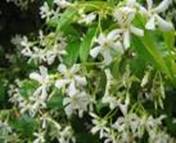| Kingdom | Plantae |
| Division | Magnoliophyta |
| Class | Magnoliopsida |
| Order | Lamiales |
| Family | Oleaceae |
| Genus | Jasminum |
| Species | J.officinale |
| Binomial name | Jasminum officinale |
Other Common Names:
The other common names for the shrub jasmine are Poets Jasmine, Common White Jasmine.
History
Jasmine, a fragrant flowering shrub found in warm and tropical climates, is known the world over for its aromatherapy, medicinal and culinary qualities. Its sweet, floral scent, strongest in the evening hours when flowers release their essential oils perfume the air around it. The Jasmine is native to tropical and warm temperate regions of the old world.

Description
Jasmine shrubs reach to a height of 10-15 feet, growing approximately 12-24 inches per year. Jasmine leaves are either evergreen or deciduous. A Jasmine leaf is arranged in opposite in most species, leaf shape is simple, trifoliate or pinnate with 5-9 leaflets, each up to two and half inches long.


Range
True jasmines are native to India, Western China and other parts of Asia including Japan, Borneo, Thailand, and some South Seas islands. Jasmine is believed to have originated in the Himalayas in western China.
Habitat
All jasmines prefer full sun to partial shade and a warm site. Jasmines grow well in moist, well drained, sandy loam to clayey garden soil with moderate level of fertility. Jasmine prefers full sun to partial shade and a warm site. It is generally seen in woodland garden, sunny Edge, dappled Shade and Shady Edge.
Cultivation
Jasmine is propagated by cuttings of nearly ripe wood in summer. Cuttings are planted in 3-inch pots within 4 weeks, then to 6-inches when pot is becoming filled with roots. The potting soil should consist of 2 parts peat moss or cow dung to 2 parts loam to 1 part sand. Keep the soil moist but well drained for optimum growth. When growth slows in winter, hold back on watering. If planted on the ground, set them at least 8 feet apart to help them bush out. Jasmine can be grown as a wine or a shrub. Frequent pruning is required to grow it as a shrub of desired size. Pruning also helps keep an abundance of flowers, since flowers are produced on new wood. When grown as a vine, its arching branches have to be supported on a mesh or trellis. Jasmine can be produced on almost any soil type, with sufficient water supply and intermediate to warm temperatures. It grows in full sun to partial shade. Fertilize monthly with a balanced fertilizer. The common jasmine grows at the rate 12 to 24 inches a year. Seeds don't need stratifying, and can be planted immediately. Full production begins after grafting in the second year. Flowers are picked in the early morning, since they are the most fragrant at daybreak. Jasmines bush out and should not be jammed together. Set them at least 8 feet apart in shrub borders. Containerized plants are best planted in the fall.
Flowering Season
The fragrant flowers bloom from June to October; and as they are found chiefly on the young shoots, the plant should only be pruned in the autumn.
Pests and Diseases
It is affected by foliage diseases transmitted by arabis mosaic viruses which show symptoms of yellow rings and blotches. They are also disturbed by tobacco ring spot and cucumber mosaic virus. General poor growth is associated with yellow blotches in young foliage plus leaf drop and in older leaves, necrotic spots and interveinal chlorosis.
Parts Used
The most commonly used parts of the plant are the roots and the flowers for its commercial and medicinal value.
Medicinal Applications


• It is used in Ayurvedic medicines.
• The flowers are aphrodisiac, antiseptic, antispasmodic, galactogogue and tonic.
• Jasmine is used for mouth ulcers, and its fresh juice is applied to corns.
• It is also used as an alternative for cancers as well as viral and bacterial infections.
• It has antidepressant, antiseptic, anti-spasmodic, sedative and uterine properties.
• Jasmine is also used to scent and flavour tea leaves and to treat headaches and insomnia.
• The leaf juice is applied to corns and ear discharges.
• The root is used in the treatment of ringworm. It is used in the treatment of depression, nervous tension, impotence, frigidity, menstrual disorders and weak digestion.
Commercial Applications

• The flower oil extracted from the two species Jasminum Officinale and Grandiflorum is used in high-grade perfumes and cosmetics, such as creams, oils, soaps, and shampoos.
• In Asia, flowers are stringed together to make garlands.
• Dried flowers of Arabian jasmine are used to flavour Jasmine tea.
• Its oil is used in perfumes and food flavourings.


The flowers of one of the double varieties are held sacred to Lord Vishnu and are used as votive offerings in Hindu religious ceremonies. Pakistan, where Jasminum officinale is known as the "Chambeli" or "Yasmine" is the national flower. Syria, it is the symbolic flower of Damascus, which is called the City of Jasmines.
This night blooming fairy vine encourages the magic of the evening - mystery, love, psychic dreams, and enchantment. The Hindus string the flowers together as neck garlands for honoured guests. Folklores say that jasmine is traditionally referred to as symbol of mother.